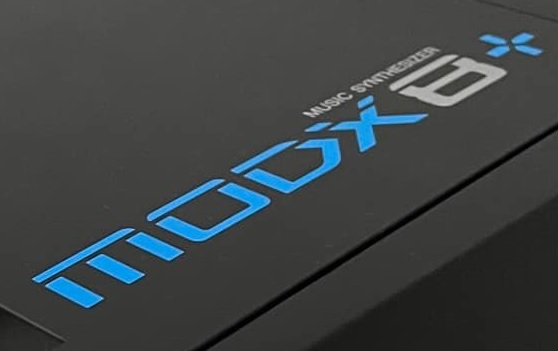[Updated 18 August 2022.] Rumors are circulating about Yamaha MODX — either replacement or refresh.
Now pictures of a misdelivered “MODX8+” have appeared. Naturally, one asks “fake or real?” Cosmetically, the only external differences are:
- A different product model legend on the right side of the top panel, e.g., “MODX8+ Music Synthesizer”.
- Black plastic end-cheeks instead of grey.
The MODX8+ was shipped mistakenly to a customer. Support anticipates release in the Sepember or October timeframe.

The new livery reminds me of the Yamaha MX series V2 spiff. It was somewhat difficult for a customer to identify an MX V1 vs. an MX V2. The new MODX+ legend makes the mark 2 clearly distinguishable. No word about enhanced features or sound set. One must also ask if the Montage will get a spiff, too?
I’m going out on a limb — real.
Update: MODX+ discussion is rampant in the forums. Here are a few quick comments, corrections and a request.
SWP70 is an integrated circuit designed by Yamaha. It is manufactured by a partner fab. Yamaha is fab-less. Yamaha transferred its semiconductor manufacturing subsidiary to Phenitec Semiconductor in 2014. It takes a lot of money to build and maintain semiconductor fabrication factories — a money losing proposition for Yamaha (or my old employer, AMD, for that matter). Yamaha remains a manufacturing powerhouse at the board level and sells its own line of PCB assembly equipment.
SWP70 processors are manufactured in batches based on Yamaha’s estimated need. Depending upon the portability of the SWP70 design, Yamaha may turn to multiple alternative partners for fab. “Portability”, in this sense, means how easily the design can be re-targeted for a specific fabrication process.
Generally, Yamaha has done a good job exploiting commodity components. The SWP70 uses ONFI-compatible NAND flash and RAM. The MODX and Montage host processors are high-volume, embedded ARM microcomputers. Although Yamaha has preferred suppliers for NAND flash and RAM (e.g., Cypress/Spansion, Winbond), these are commodity parts and are available from many suppliers. Commodity components are probably not a pressure point.
As I’ve said before, Yamaha have just a few critical external supply vulnerabilities. Aside from fab capacity, SWP70s or other Yamaha proprietary processors are likely not the issue here. When it comes to DACs and ADCs, however, Yamaha is very reliant on Asahi Kasei Microdevices (AKM). AKM is still trying to recover from its factory fire. The AKM supply shortage has put Yamaha and many other vendors on the back foot.
Yamaha have the right to substitute components. Every manual has the following disclaimer:
Specifications and descriptions in this owner’s manual are for information purposes only. Yamaha Corp. reserves the right to change or modify products or specifications at any time without prior notice. Since specifications, equipment or options may not be the same in every locale, please check with your Yamaha dealer. Visit the web page for information on the latest Owner’s manual.
Of course, this could mean substituting for AKM devices. DACs and ADCs communicate via the I2S digital audio interface format. If Yamaha did substitute — speculation — would we hear an audible change?
Much speculation surrounds the second, unpopulated SWP70 position (TG slave) on the original MODX printed circuit board. The TG slave has an associated open position for DSP RAM only. Thus, if Yamaha choose to use the same board and to populate the open positions, these changes would bring MODX+ up to the same polyphony spec and tone generation horsepower as the current Montage. Montage would still have the advantage in digital audio routing and processing (including audio channels over USB). The original MODX board does not have provisions for upgraded audio channels.
A product spin is needed when a Yamaha proprietary component is obsoleted and out of inventory. Such may be the case with the venerable SSP2 — a workhorse in many Yamaha products including mixers, Reface CS and Reface DX. Yamaha and Steinberg have moved on to the SSP3.
Finally, a request. Please do not publicly reveal your source of leaks. Yamaha are incredibly paranoid, exceeded only by Apple and Sony in this regard. First, leaks get real people in trouble. Second, Yamaha learn from their mistakes. Protect your sources and methods!
Copyright © 2022 Paul J. Drongowski
